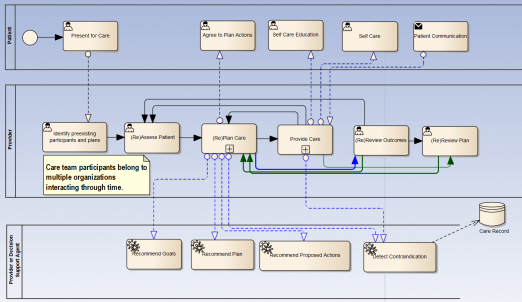Difference between revisions of "Care Planning"
(Care Planning Process) |
|||
| Line 1: | Line 1: | ||
| − | =Care Planning and Execution: | + | =Care Planning and Execution: A Dynamic and unfolding Process for Care Coordination= |
| − | |||
| − | |||
| Line 28: | Line 26: | ||
'''Figure 2 Care Process with Dynamic Assessment, Plan, Review Cycles''' | '''Figure 2 Care Process with Dynamic Assessment, Plan, Review Cycles''' | ||
| + | |||
| + | |||
| + | =Care Planning Process= | ||
| + | TODO | ||
Latest revision as of 15:27, 12 February 2013
Care Planning and Execution: A Dynamic and unfolding Process for Care Coordination
Care planning and provisioning is a dynamic process which is continuosly unfolding. It unfolds through a continuous conversation between the patient, her care team and family or social support group. This conversation happens in many places and at different times. Capturing the essence of the conversation is necessary to eliminate silos of care and support near real time awareness for the 20% of patients when it makes the greatest difference. A continumm of care only becomes possible when the ongoing conversation is captured in order to establish a common context for all participants who are working towards the patient goals. Conversation is social, dynamic, ongoing and it feeds into the expert descision making characteristic of the care process. The ongoing conversation directly supports collaboration and care coordination; without it you end up with delays in acquisition of critical information or worst in gaps of knowledge which result in unnecessary risks for the patient.
Figure 1 - Who, What and Where of Goal oriented Care Planning and Execution
The essential topics in the ongoing conversation include:
- Expression of patient preferences for care as a key input to agreement to any action plan for care
- Declaration of things which have to be managed, controlled or mitigated
- Health Concerns/Problems, Health Risks, Care Barriers
- Declaration of patient care goals and a timeline
- Specification of the action plan to achieve the set goals and reduce or eliminate health concerns, health risks and barriers to care
- Agreement of proposed care
- Review of outcomes and overall plan (care plan, plan of care or treatment plan)
The process can be supported by clinical guidelines and protocols but still requires any number of customization for individual patients. The process must also be flexible so it can accommodate any of the multiple specialties and care perspectives. The care planning process is directly supported by the HL7 Care Plan domain analysis model (DAM) and the HL7 SOA CCS health services specification.
The process is non-linear, there are many participants, it may happen in many places and it is continuously unfolding. The following “dynamic” BPMN diagram illustrates the nature of the process. Notice the re-assessment, re-planning and re-review of outcomes and the overall plan may occur in any order.
Figure 2 Care Process with Dynamic Assessment, Plan, Review Cycles
Care Planning Process
TODO

